Global Data Center Construction Market By Construction Type, By Tier Type, By Industry Vertical, By Region & Segmental Insights Trends and Forecast, 2024 – 2034
- Industry: Technology
- Report ID: TNR-110-1243
- Number of Pages: 420
- Table/Charts : Yes
- August, 2024
- Base Year : 2024
- No. of Companies : 10+
- No. of Countries : 29
- Views : 10079
- Covid Impact Covered: Yes
- War Impact Covered: Yes
- Formats : PDF, Excel, PPT
The data center construction market is experiencing robust growth, driven by the increasing demand for cloud services, the expansion of digital infrastructure, and the rise of edge computing. Key trends include the adoption of energy-efficient designs, modular data centers, and the integration of AI and IoT for optimized operations. The market is also seeing a shift towards sustainable construction practices, with a focus on green building certifications and renewable energy usage.
Opportunities abound in emerging markets, where data center demand is surging due to digital transformation initiatives. Additionally, the growth of 5G technology and the proliferation of data-driven applications are creating significant opportunities for further market expansion. In terms of revenue, the global data center construction market was worth US$ 298.2 Bn in 2023, anticipated to witness a CAGR of 8.2% during 2024 – 2034.
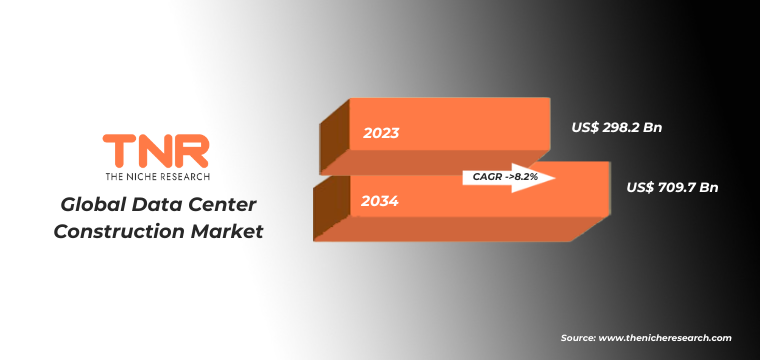
Global Data Center Construction Market Segmental Analysis:
Data Center Construction Market By Construction Type
Mechanical segment has rapidly emerged as the fastest-growing segment in the global data center construction market, driven by the increasing need for efficient cooling and ventilation systems in modern data centers. As data centers expand in size and complexity, managing heat generated by high-density servers and other equipment has become critical. Advanced cooling technologies, such as liquid cooling and modular cooling systems, are gaining traction for their ability to optimize energy consumption and reduce operational costs. The growing emphasis on sustainability and energy efficiency further propels the demand for innovative mechanical solutions, making this segment a key focus for industry investments.
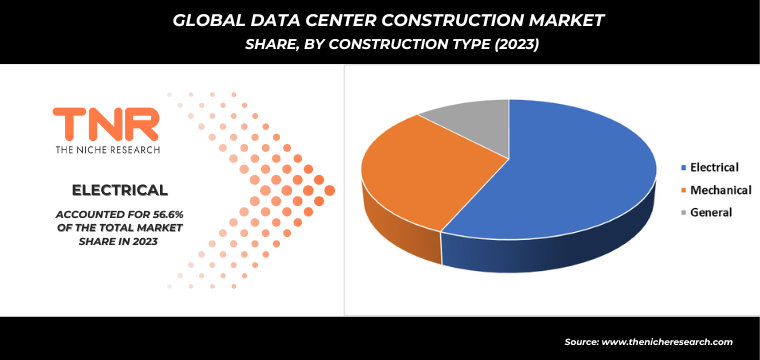
Data Center Construction Market By Tier Type
In 2023, the tier 3 segment dominated the global data center construction market, capturing a substantial revenue share of 39.6%. This dominance is attributed to the rising demand for data centers that offer a balance between cost-efficiency and high availability. Tier 3 data centers, known for their concurrently maintainable infrastructure, provide enhanced redundancy and uptime, making them a preferred choice for businesses requiring reliable performance without the high costs associated with Tier 4 facilities. The growing adoption of cloud services and digital transformation initiatives has further fueled the demand for Tier 3 data centers globally.
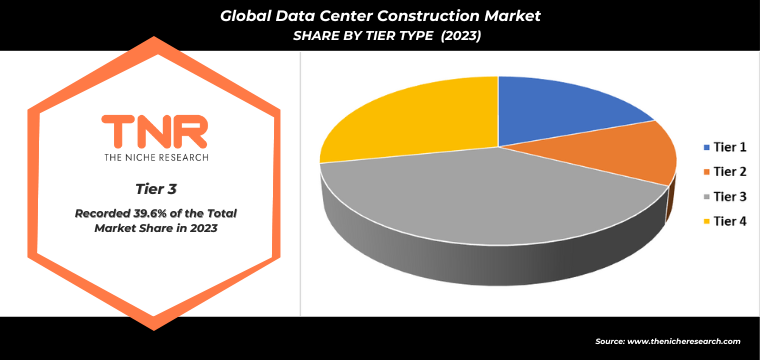
Data Center Construction Market By Industry Vertical
IT and telecom emerged as the dominant segment in the global data center construction market in 2023, capturing a significant revenue share of 20.1%. This growth is driven by the increasing reliance on digital infrastructure and the exponential rise in data consumption, particularly in the telecommunications industry. The expansion of 5G networks, cloud computing, and IoT technologies has necessitated the construction of advanced data centers to support massive data traffic and ensure seamless connectivity. The sector’s ongoing digital transformation initiatives, including the shift to virtualized and software-defined networks, have further accelerated investments in robust, scalable data center infrastructures to meet evolving demands.
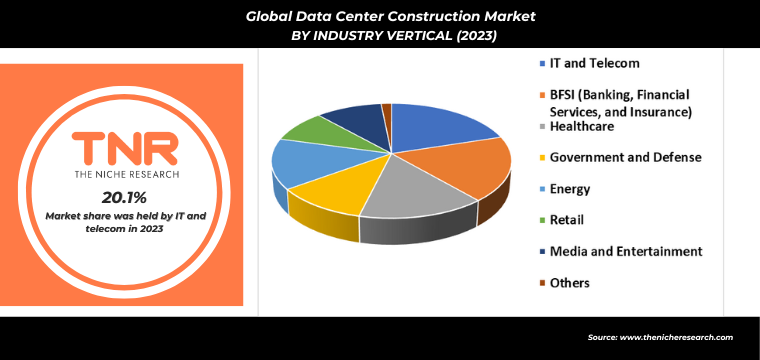
Data Center Construction Market By Region
Asia Pacific is projected to be the fastest-growing region in the data center construction market during the forecast period, driven by the rapid digital transformation across emerging economies like China, India, and Southeast Asian countries. The region is witnessing significant investments from global tech giants to establish data centers that support cloud computing, AI, and big data analytics. The expansion of e-commerce, social media, and online services is also fueling demand for data centers. Additionally, government initiatives promoting digital infrastructure development and 5G rollouts are further propelling market growth in the region.
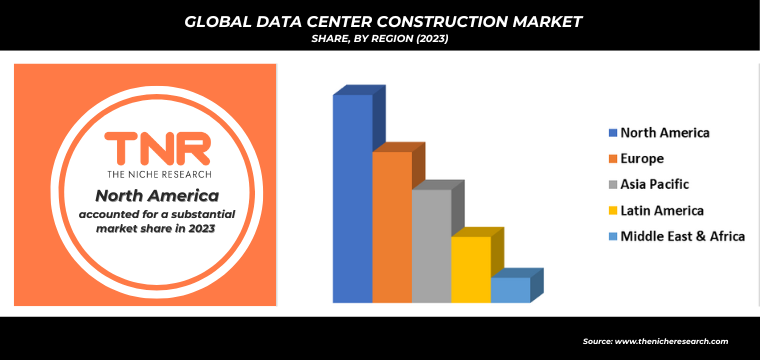
Global Data Center Construction Market Dynamics
Global Data Center Construction Market Growth Driver:
The global data center construction market is primarily driven by the exponential growth in data generation and the increasing adoption of cloud services across various industries. The surge in demand for data storage, processing, and real-time data analytics, especially in the IT, telecom, and financial sectors, has necessitated the expansion of data center infrastructures. The rise of 5G technology and edge computing is prompting investments in new data center facilities to reduce latency and enhance network efficiency. Government initiatives supporting digital transformation and the growing focus on renewable energy are also key market drivers.
Global Data Center Construction Market Restraint:
The global data center construction market faces challenges from high initial capital expenditures and ongoing operational costs associated with building and maintaining data centers. The need for significant investments in advanced cooling systems, power supply, and security infrastructure can be a financial burden for organizations, especially smaller players. Concerns around data security and compliance with regulatory standards in different regions pose potential barriers to market growth. The market is also sensitive to economic fluctuations, which can delay construction projects or reduce the scale of planned expansions, impacting overall market development.
Global Data Center Construction Market Opportunity:
The global data center construction market offers substantial growth opportunities, particularly in emerging economies where digital infrastructure is rapidly expanding. The increasing adoption of modular and prefabricated data centers presents cost-effective and scalable solutions, catering to the growing demand for flexible and quick deployments. The trend towards green and energy-efficient data centers, driven by environmental regulations and corporate sustainability goals, opens avenues for innovation in design and construction. The rise of artificial intelligence (AI), big data, and the Internet of Things (IoT) is driving demand for advanced data center facilities, creating opportunities for market players to capitalize on technological advancements.
Global Data Center Construction Market Threat:
The global data center construction market faces several threats that could impact its growth trajectory. Rapid technological advancements, while offering opportunities, also pose the risk of obsolescence for existing infrastructure, leading to potential financial losses. Cybersecurity threats and data breaches remain significant concerns, as data centers are prime targets for attacks, which could deter investment. Supply chain disruptions, particularly in the procurement of critical components like semiconductors and power systems, could delay construction projects. Environmental concerns related to energy consumption and e-waste management could lead to stricter regulations, potentially increasing operational costs.
Competitive Landscape
The global data center construction market is highly competitive, with key players including ABB, IBM, Hewlett Packard Enterprise Development LP, and Schneider Electric. Companies are focusing on technological advancements, sustainable building practices, and strategic partnerships to gain a competitive edge and expand their market presence.
Some of the players operating in the data center construction market are
- ABB
- Acer Inc.
- Ascenty
- Cisco Systems, Inc.
- Dell Inc.
- Equinix, Inc.
- Fujitsu
- Gensler
- Hewlett Packard Enterprise Development LP
- Hitachi, Ltd.
- HostDime Global Corp.
- Huawei Technologies Co., Ltd.
- IBM
- INSPUR Co., Ltd.
- IPXON Networks
- KIO
- Lenovo
- Oracle
- Schneider Electric
- Vertiv Group Corp.
- Other Industry Participants
Global Data Center Construction Market Scope
| Report Specifications | Details |
| Market Revenue in 2023 | US$ 298.2 Bn |
| Market Size Forecast by 2034 | US$ 709.7 Bn |
| Growth Rate (CAGR) | 8.2% |
| Historic Data | 2016 – 2022 |
| Base Year for Estimation | 2023 |
| Forecast Period | 2024 – 2034 |
| Report Inclusions | Market Size & Estimates, Market Dynamics, Competitive Scenario, Trends, Growth Factors, Market Determinants, Key Investment Segmentation, Product/Service/Solutions Benchmarking |
| Segments Covered | By Construction Type, By Tier Type, By Industry Vertical, By Region |
| Regions Covered | North America, Europe, Asia Pacific, Middle East & Africa, Latin America |
| Countries Covered | U.S., Canada, Mexico, Rest of North America, France, The UK, Spain, Germany, Italy, Nordic Countries (Denmark, Finland, Iceland, Sweden, Norway), Benelux Union (Belgium, The Netherlands, Luxembourg), Rest of Europe, China, Japan, India, New Zealand, Australia, South Korea, Southeast Asia (Indonesia, Thailand, Malaysia, Singapore, Rest of Southeast Asia), Rest of Asia Pacific, Saudi Arabia, UAE, Egypt, Kuwait, South Africa, Rest of Middle East & Africa, Brazil, Argentina, Rest of Latin America |
| Key Players | ABB, Acer Inc., Ascenty, Cisco Systems, Inc., Dell Inc., Equinix, Inc., Fujitsu, Gensler, Hewlett Packard Enterprise Development LP, Hitachi, Ltd., HostDime Global Corp., Huawei Technologies Co., Ltd., IBM, INSPUR Co., Ltd., IPXON Networks, KIO, Lenovo, Oracle, Schneider Electric, Vertiv Group Corp. |
| Customization Scope | Customization allows for the inclusion/modification of content pertaining to geographical regions, countries, and specific market segments. |
| Pricing & Procurement Options | Explore purchase options tailored to your specific research requirements |
| Contact Details | Consult With Our Expert
Japan (Toll-Free): +81 663-386-8111 South Korea (Toll-Free): +82-808- 703-126 Saudi Arabia (Toll-Free): +966 800-850-1643 United Kingdom: +44 753-710-5080 United States: +1 302-232-5106 E-mail: askanexpert@thenicheresearch.com
|
Global Data Center Construction Market
By Construction Type
- Electrical
- Power Distribution Units (PDUs)
- Uninterruptible Power Supply (UPS) Systems
- Generators
- Transfer Switches & Switchgear
- Others
- Mechanical
- Cooling Systems
- Air Handling Units (AHUs)
- Racks
- Others
- General
- Building Design and Architecture
- Interior Fit-out
- Construction Management and Commissioning
- Others
By Tier Type
- Tier 1
- Tier 2
- Tier 3
- Tier 4
By Industry Vertical
- IT and Telecom
- BFSI (Banking, Financial Services, and Insurance)
- Healthcare
- Government and Defense
- Energy
- Retail
- Media and Entertainment
- Others
By Region
- North America (U.S., Canada, Mexico, Rest of North America)
- Europe (France, The UK, Spain, Germany, Italy, Nordic Countries (Denmark, Finland, Iceland, Sweden, Norway), Benelux Union (Belgium, The Netherlands, Luxembourg), Rest of Europe)
- Asia Pacific (China, Japan, India, New Zealand, Australia, South Korea, Southeast Asia (Indonesia, Thailand, Malaysia, Singapore, Rest of Southeast Asia), Rest of Asia Pacific)
- Middle East & Africa (Saudi Arabia, UAE, Egypt, Kuwait, South Africa, Rest of Middle East & Africa)
- Latin America (Brazil, Argentina, Rest of Latin America)
Report Layout:
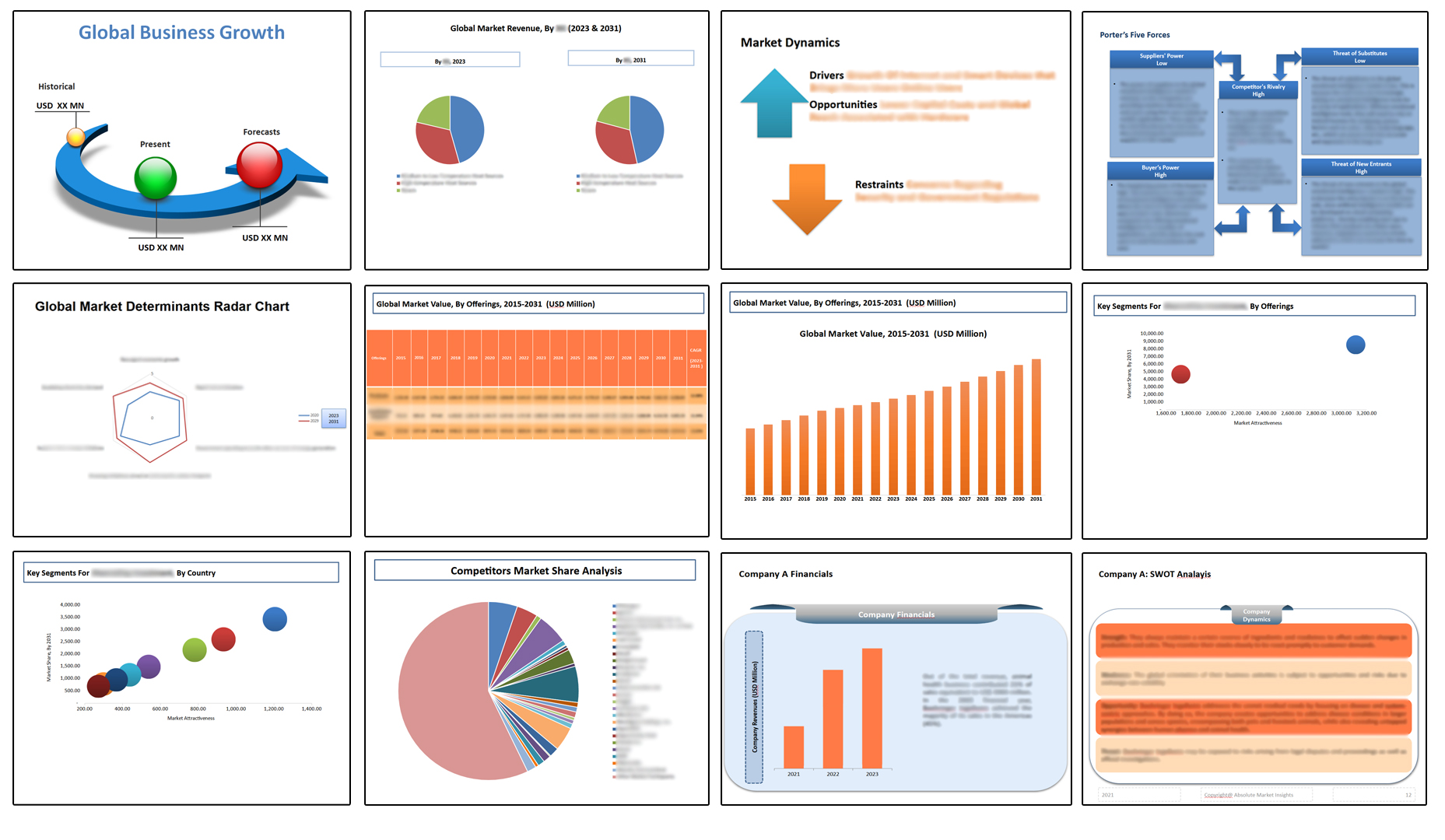
Table of Contents
Note: This ToC is tentative and can be changed according to the research study conducted during the course of report completion.
**Exclusive for Multi-User and Enterprise User.
Global Data Center Construction Market
By Construction Type
- Electrical
- Power Distribution Units (PDUs)
- Uninterruptible Power Supply (UPS) Systems
- Generators
- Transfer Switches & Switchgear
- Others
- Mechanical
- Cooling Systems
- Air Handling Units (AHUs)
- Racks
- Others
- General
- Building Design and Architecture
- Interior Fit-out
- Construction Management and Commissioning
- Others
By Tier Type
- Tier 1
- Tier 2
- Tier 3
- Tier 4
By Industry Vertical
- IT and Telecom
- BFSI (Banking, Financial Services, and Insurance)
- Healthcare
- Government and Defense
- Energy
- Retail
- Media and Entertainment
- Others
By Region
- North America (U.S., Canada, Mexico, Rest of North America)
- Europe (France, The UK, Spain, Germany, Italy, Nordic Countries (Denmark, Finland, Iceland, Sweden, Norway), Benelux Union (Belgium, The Netherlands, Luxembourg), Rest of Europe)
- Asia Pacific (China, Japan, India, New Zealand, Australia, South Korea, Southeast Asia (Indonesia, Thailand, Malaysia, Singapore, Rest of Southeast Asia), Rest of Asia Pacific)
- Middle East & Africa (Saudi Arabia, UAE, Egypt, Kuwait, South Africa, Rest of Middle East & Africa)
- Latin America (Brazil, Argentina, Rest of Latin America)
The Niche Research approach encompasses both primary and secondary research methods to provide comprehensive insights. While primary research is the cornerstone of our studies, we also incorporate secondary research sources such as company annual reports, premium industry databases, press releases, industry journals, and white papers.
Within our primary research, we actively engage with various industry stakeholders, conducting paid interviews and surveys. Our meticulous analysis extends to every market participant in major countries, allowing us to thoroughly examine their portfolios, calculate market shares, and segment revenues.
Our data collection primarily focuses on individual countries within our research scope, enabling us to estimate regional market sizes. Typically, we employ a bottom-up approach, meticulously tracking trends in different countries. We analyze growth drivers, constraints, technological innovations, and opportunities for each country, ultimately arriving at regional figures.Our process begins by examining the growth prospects of each country. Building upon these insights, we project growth and trends for the entire region. Finally, we utilize our proprietary model to refine estimations and forecasts.
Our data validation standards are integral to ensuring the reliability and accuracy of our research findings. Here’s a breakdown of our data validation processes and the stakeholders we engage with during our primary research:
- Supply Side Analysis: We initiate a supply side analysis by directly contacting market participants, through telephonic interviews and questionnaires containing both open-ended and close-ended questions. We gather information on their portfolios, segment revenues, developments, and growth strategies.
- Demand Side Analysis: To gain insights into adoption trends and consumer preferences, we reach out to target customers and users (non-vendors). This information forms a vital part of the qualitative analysis section of our reports, covering market dynamics, adoption trends, consumer behavior, spending patterns, and other related aspects.
- Consultant Insights: We tap into the expertise of our partner consultants from around the world to obtain their unique viewpoints and perspectives. Their insights contribute to a well-rounded understanding of the markets under investigation.
- In-House Validation: To ensure data accuracy and reliability, we conduct cross-validation of data points and information through our in-house team of consultants and utilize advanced data modeling tools for thorough verification.
The forecasts we provide are based on a comprehensive assessment of various factors, including:
- Market Trends and Past Performance (Last Five Years): We accurately analyze market trends and performance data from preceding five years to identify historical patterns and understand the market’s evolution.
- Historical Performance and Growth of Market Participants: We assess the historical performance and growth trajectories of key market participants. This analysis provides insights into the competitive landscape and individual company strategies.
- Market Determinants Impact Analysis (Next Eight Years): We conduct a rigorous analysis of the factors that are projected to influence the market over the next eight years. This includes assessing both internal and external determinants that can shape market dynamics.
- Drivers and Challenges for the Forecast Period:Identify the factors expected to drive market growth during the forecast period, as well as the challenges that the industry may face. This analysis aids in deriving an accurate growth rate projection.
- New Acquisitions, Collaborations, or Partnerships: We keep a close watch on any new acquisitions, collaborations, or partnerships within the industry. These developments can have a significant impact on market dynamics and competitiveness.
- Macro and Micro Factors Analysis:A thorough examination of both macro-level factors (e.g., economic trends, regulatory changes) and micro-level factors (e.g., technological advancements, consumer preferences) that may influence the market during the forecast period.
- End-User Sentiment Analysis: To understand the market from the end-user perspective, we conduct sentiment analysis. This involves assessing the sentiment, preferences, and feedback of the end-users, which can provide valuable insights into market trends.
- Perspective of Primary Participants: Insights gathered directly from primary research participants play a crucial role in shaping our forecasts. Their perspectives and experiences provide valuable qualitative data.
- Year-on-Year Growth Trend: We utilize a year-on-year growth trend based on historical market growth and expected future trends. This helps in formulating our growth projections, aligning them with the market’s historical performance.
Research process adopted by TNR involves multiple stages, including data collection, validation, quality checks, and presentation. It’s crucial that the data and information we provide add value to your existing market understanding and expertise. We have also established partnerships with business consulting, research, and survey organizations across regions and globally to collaborate on regional analysis and data validation, ensuring the highest level of accuracy and reliability in our reports.









